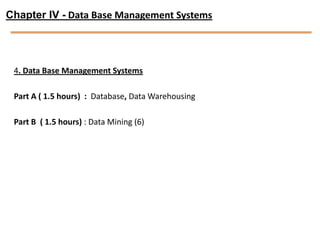
Mis chapter 4 database management - copy
- 1. Chapter IV - Data Base Management Systems 4. Data Base Management Systems Part A ( 1.5 hours) : Database, Data Warehousing Part B ( 1.5 hours) : Data Mining (6)
- 2. Chapter III - Data Base Management Systems Data Base Management Systems Part A ( 1.5 hours) : Database, Data Warehousing
- 3. Database Database: Database can be defined as a) “A mechanical or automated, formally defined, centrally controlled collection of data in an organization” b) “A collection of data organized to service users or applications at the same time and managing data so that they appear to be in one location” Data records are physically organized and stored. It helps in sharing , availability, evolving, integrity. Database Management system (DBMS): DBMS is basically a software system which performs the functions of defining, Creating, revising and controlling the database.
- 4. Components and role of DBMS Components of DBMS: 1. Data Definition Language (DDL): it defines each data as it appears in the database. The data element is then translated into the format desired or required by the applications programme. 2. Data Manipulation Language (DML) : it is used by end-users and programmers to manipulate data in the database. It consists of commands which enables end users and programmers to extract data from the database to satisfy information requests and develop applications. 3. Data Dictionary : this is the repository of information about data. It defines each data elements such as name, description, validation, criteria, security calculations, sources, keywords search types etc. Role or Usefulness of data dictionary: 1) It defines data element 2) It helps in scheduling and control 3) Permits users to know which data is available and how can it be obtained 4) It helps to identify organizational data irregularity, if any 5) It acts as glossary (vocabulary) of growing information resources. 6) It serves as an important data management tool 7) It provides report facility.
- 5. Database Models There are three types of Database Models: 1. Hierarchical Database Model (HDBM): This is an old model. It follows the structure of the organization. This represents data in a pyramidal or tree structure. Each record appears to be like an organizational chart with one top level segment called the root, spreading downwards into branches. It will have parent-child relationship. It will have one to many relationship. 2. Network Database Model (NDBM): it has many to many relationship in the database system. It does not has any specific file structure as such. This is also old model. 3. Relational Database Model (RDBM): This is recent model of database proposed by Dr. E.F. Codd. It represents the data in database as simple two dimensional tables called Relations. The table has rows and columns, rows represents individual records and columns represents attributes of each record. 1. Basic Operations user in RDBMS a) Select - used to create t the records b) Project- used by the users to view or creating existing information. c) Join – used to combine the tables
- 6. Advantages of DBMS 1. It helps in central controlling and managing of data like access, utilization and security. 2. It helps in reducing redundancy and inconsistency of data 3. It provides integrity of data 4. It helps in central controlling of data creation thereby elimination of data confusion 5. It reduces the cost of program development and maintenance 6. It helps in logical view and physical arrangement of file and data and thereby reduces programme data dependence 7. It provides flexibility (e.g. ad-hoc queries etc.) 8. It increase the access and availability of information.
- 7. DEMO of Relational Database Model (RDBM)
- 8. Data Warehouse Data Warehouse “Data warehouse is a new technology that provides the users with the tool to store summarized information from multiple heterogeneous database in a single repository” W.H. Inmon Defines “ a data warehouse is a subject-oriented, integrated, time varying, non-volatile collection of data in support of the management’s decision making process” 1. subject-oriented (driven)- it is organized the way it is suitable for decision making and not as per the organization functions 2. Integrated – fully integrated 3. time varying – old data only 4. non-volatile - not changing.
- 9. Functions and Benefits of Data Warehouse Functions (what does data warehouse do?) 1. It helps integrate data from heterogeneous sources 2. It consolidates and stores the data in step-by-step fashion 3. It supports management in taking decision. 4. It is a critical component in DSS and EIS 5. It helps in providing summarized, historical and analytical for decision making 6. It optimizes the efforts of consolidation, conversion, transformation and integration of data Benefits from Data Warehouse: 1. Time saving for data suppliers and for users 2. More and better information 3. Better decision 4. Improvement of business processes 5. Support for the accomplishment of strategic business objectives.
- 10. Chapter III - Data Base Management Systems Part B ( 1.5 hours) : Data Mining (6)
- 11. Data Mining • Data mining helps in extracting partners, trends and rules from the data warehouse to evaluate either predict or scour proposed business strategies which in turn will improve competitiveness, improves profits and transform business processes.
